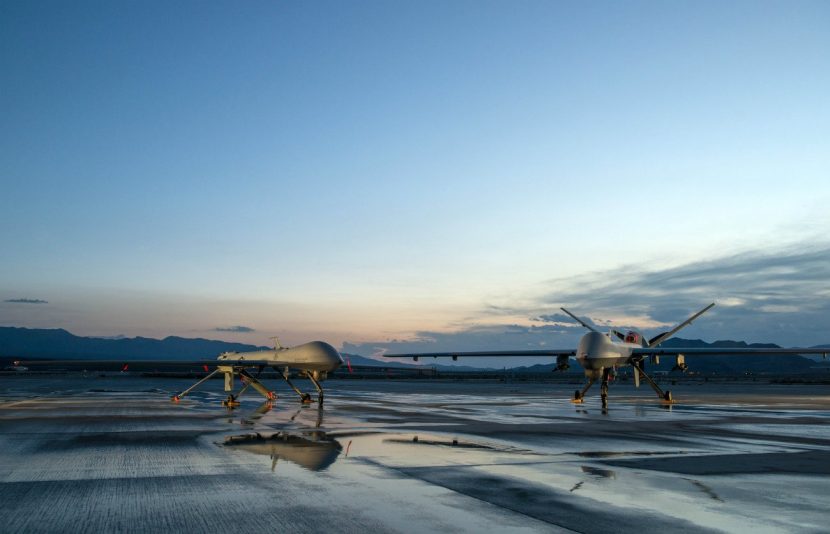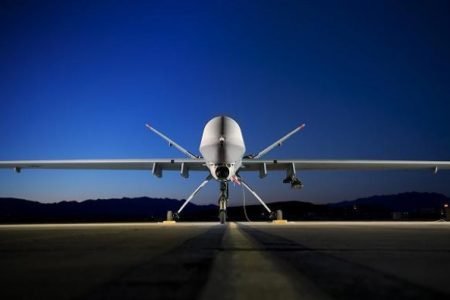The MQ – 9 Reaper is an offensive strike, unmanned US Airforce drone which made its first flight on February 2nd, 2001. The “M” represents Multi-role, as designated by the Department of Defense and “Q” denotes a remotely piloted aircraft system. The “9” indicates; it is the ninth in the series of remotely piloted aircraft systems.
The MQ – 9 Reaper is much superior to its predecessor, the MQ-1B Predator, in terms of size, speed, ordnance capacity, and efficiency. It has been named ‘Grim Reaper’ due to its deadly features. According to the Air Force, “The MQ – 9 Reaper is an armed, multi-mission, medium-altitude, long-endurance remotely piloted aircraft that is employed primarily against dynamic execution targets and secondarily as an intelligence collection asset.”

Contents
Significant services by the MQ – 9 Reaper Drone
The MQ – 9 Reaper has been in service since 2007 and has endured numerous operations in Afghanistan, Iraq, Yemen, Libya, and several other countries.
It scored its first kill on October 28th, 2007 in Afghanistan, where it killed insurgents with a Hellfire missile. On November 12th, 2005, it killed Jihadi John in Syria. It has recently become the center of attention after killing Iranian major general and commander, Qassem Soleimani under the commands of US President Trump on January 3rd, 2020. The strike also killed the deputy commander of Iraq’s Iranian-backed Popular Mobilization Forces, Abu Mahdi al Muhandis. He was also the founder of Kataib Hezbollah, an insurgent group that killed a U.S. contractor in December in a rocket attack.
Retired Air Force Lt. Gen. David Deptula told the Washington Examiner: “The MQ – 9 Reaper is the perfect weapon system for this job and highlights airpower’s ability to project accurate, timely, and lethal power,” Deptula said. “The strike was a measured and appropriate response after 18 months of restraint by the Trump administration to a series of aggressive Iranian violations of international law. He set a red line, warned Iran not to cross it, and when they did, he acted appropriately to defend American personnel and interests. “
General specifications of the MQ – 9 Reaper
The MQ – 9 Reaper, developed by General Atomics, stretches along 36 feet and stands 12.5 feet tall, and weighs 4900 pounds (2223 kilograms). With a wingspan of 66 feet, it cruises at a speed of 230 mph at altitudes of 50,000 feet and a range of 1200 miles. Once its 602 – gallon fuel tank is repleted, it can hold out for 14 hours. Two external 150 – gallon tanks can fuel the MQ – 9 for 42 hours. The per unit cost of MQ – 9 Reaper is $64.2 million which includes multiple sensors, GCSS (Global Combat Support System), and Communication Systems, which are discussed later in detail. General Atomics is one of the few leading defense contractors that are not publicly traded.
The Reaper is a silent killer, as it can fly at great speeds while barely producing any noise. In December 2019, it was sighted during a flyover at approximately 800 – 1000 feet. As reported by The Aviationist, “Air show fans, used to ear-splitting Thunderbirds sneak-passes and airpower demo pyrotechnics, were struck by the stark contrast of the quiet little aircraft with the slowly turning four-bladed propeller that snuck into the airspace, made a single pass, and then silently faded off into the heat-haze of the secret test ranges to the north of Nellis from where it came. The fly-over, the first of its kind at Nellis, sent a collective shiver up air show viewers’ spines. It was a significant acknowledgment of the rapidly evolving and expanding role of Remotely Piloted Aircraft in the U.S. Air Force.”
Combat Attributes of the MQ – 9 Reaper
The MQ-9 is geared up with unmatched features that contribute to its exceptional performance on the battlefield. Few of the combat attributes of the drone are mentioned in detail as follows:
Multi-Spectral Targeting System
Raytheon’s MTS-B, or the Multi-Spectral Targeting System, is an electro – optical infrared (EO/IR) and a laser detecting-ranging-tracking set which incorporates an infrared sensor, color/monochrome daylight TV camera, image-intensified TV camera, laser range designator, and laser illuminator.
Remote Operations
The MQ – 9 Reaper is part of a remotely piloted aircraft system that consists of several sensor/weapon-equipped aircrafts, Ground Control Stations, Predator Primary Satellite Link which provides communications between the ground station and the aircraft, and spare equipment along with operations and maintenance crews for deployed 24-hour missions.
The MQ-9 requires a maximum of 3 remote crew members; a pilot, a sensor operator, and a mission coordinator, if necessary. The Reaper is operated from the Ground Control Station. The thermalized camera on-board conveys video streams, which allows the crew-members to operate the MQ – 9 Reaper, deploy weapons, track down targets, and inspect the terrain proficiently.
Equipped with a diverse range of weapons
- The laser range finder/designator, such as the Guided Bomb Unit-12 Paveway II, integrated into the MQ – 9 Reaper has the ability to discreetly identify and designate a target.
- The Reaper also comes with a synthetic aperture radar to enable future GBU-38 Joint Direct Attack Munitions targeting, which allows the Reaper to independently navigate the desired location.
- The MQ-9 utilizes four laser-guided, Air-to-Ground Missile (AGM)-114 Hellfire missiles, which provide highly accurate, low-collateral damage, anti-armor, and anti-personnel engagement capabilities. It is designed to take down targets within a specified time with utmost precision.
Extended Capabilities
In June 2015, a study conducted by the USAF’s Scientific Advisory Board identified several improvements for operating the Reaper in contested airspace; adding readily available sensors, weapons, and threat detection and countermeasures to help boost situational awareness and enable riskier deployments.
Suggestions included:
- A radar warning receiver to know when the Reaper is being targeted
- Air-to-air and miniature air-to-ground weapons
- Manned-unmanned teaming
- Multi-UAV control
- Automatic take-offs and landings
- Accurate navigation and timing systems to fly in GPS-denied areas
Another proposal was to redesign the Ground Control Stations with user-friendly controllers resembling video games, and touchscreen maps for convenient access to data for the benefit of the operators.
Recent upgrades have empowered the Reaper to take-off and land autonomously by following the coordinates entered remotely by a pilot, thousands of miles away. This allows the Reaper to land in areas without a Ground Control Station under satellite communication.
Due to this competent US drone, operations can be conducted with a smaller number of deployed personnel and simplified command and control. The crew can conveniently direct the US Airforce drone via undetectable links. Such advanced upgrades and high-tech features have shaped the hostile MQ – 9 Reaper into the reputable drone it is today.







